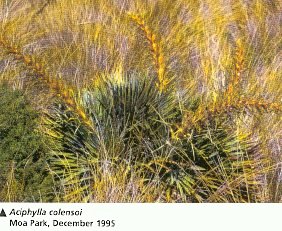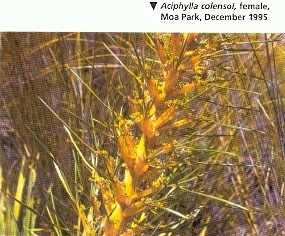|
 Alpine
Plants Alpine
Plants
of New Zealand
Aciphylla
colensoi
Speargrass
/ Spaniard
Family
APIACEAE
 Reproduced
from Reproduced
from
Alpine Plants of New Zealand
ISBN 0 7900 0525 5
by kind permission of the author, Lawrie Metcalf and Reed Publishing
(NZ) Ltd
Publication or other use of images or descriptive
text on these pages is unauthorised unless written permission is
obtained from the author and publisher. Appropriate acknowledgement
of the publication Alpine Plants of New Zealand must always
be given.
Description
- A large herb arising
from a strong taproot and forming single or multiple rosettes
of very sharp, spine-tipped leaves. The clumps may be up to 90
cm in diameter and 40-50 cm high.
- Leaves: Rigid,
divided into long and narrow segments, all pointing forwards and
outwards in all directions. Usually leaves are green or greyish-green
with prominent orange or reddish midribs.
- Flowers:
Small, yellowish flowers are produced in dense clusters along
strong stems up to a metre or so tall. Long, narrow spines project
out from amongst the flowers to give the appearance of quite a
formidable protection.
 Distribution
& Habitat Distribution
& Habitat
- North and South Islands
from Mount Hikurangi to mid Canterbury. Widespread in subalpine
to low-alpine areas. 900-1500 metres.
- Often prominent in
subalpine scrub, mixed snow tussock-scrub, herbfields and in grasslands.
Usually in moister situations.
Notes
- Identification:
This fierce-looking plant is particularly conspicuous at flowering
time when the bright orange flowering stems stand out from afar.
With all species of speargrass the male and female flowers are
on separate plants with the male usually being the more showy.
- Related species:
There are some 40 species of Aciphylla, most of which occur
in alpine regions. They range from quite small species no more
than a few centimetres tall to those up to 2 metres or more tall
at flowering.
- Other: Some
have thought the spiny nature of speargrasses to have been a protection
against the browsing activities of the now extinct moa, but in
view of the ease with which introduced animals such as sheep,
rabbits and hares browse on them the spines are unlikely to have
afforded much protection against browsing moa. A more likely explanation
is that the spiny nature of the plant is a response to habitat,
particularly as a means of moderating the effects of dessicating
winds.
Web-notes:
Alpine Garden Links
On
this site
Reproduced from Alpine Plants
of New Zealand:
Also see the article
by Raymond Mole on:
New Zealand Alpine Plants: A Challenge for
Growers
 External
Links External
Links
New
Zealand Alpine Garden Society
More
Plant Profiles
|



 Reproduced
from
Reproduced
from Distribution
& Habitat
Distribution
& Habitat